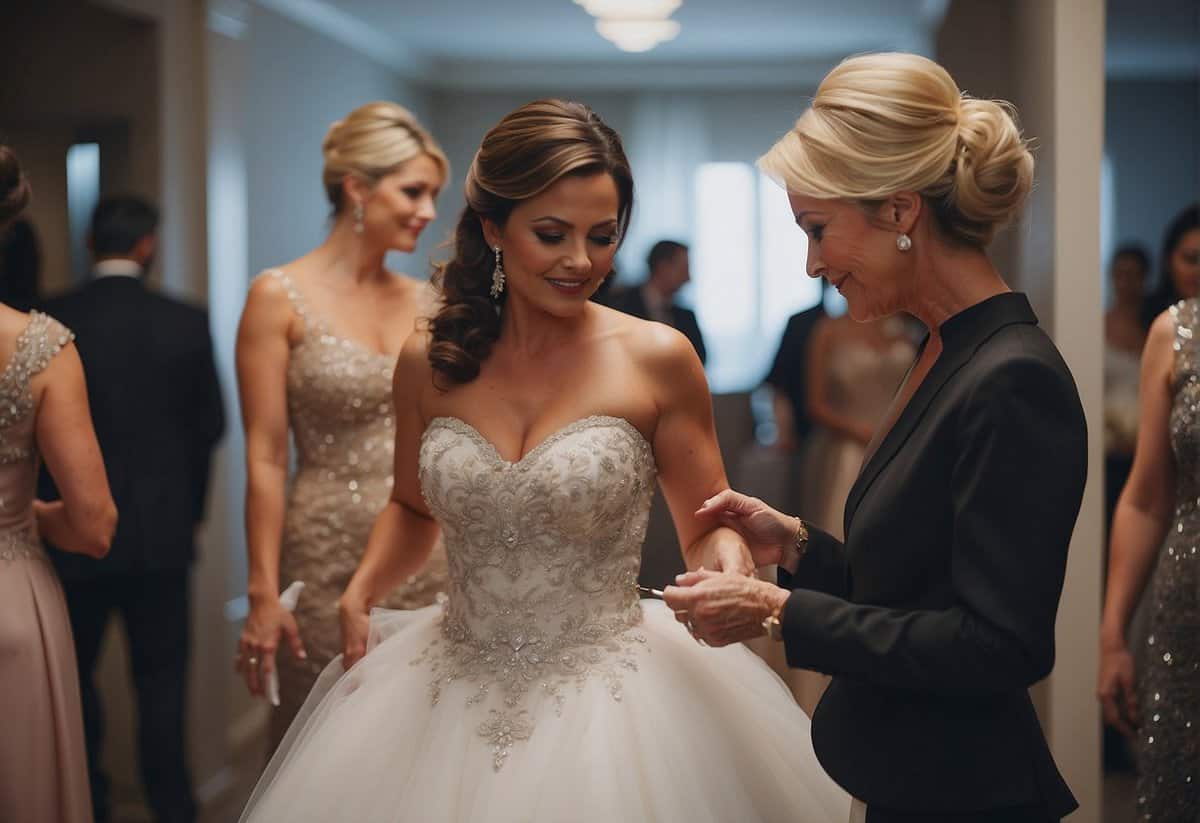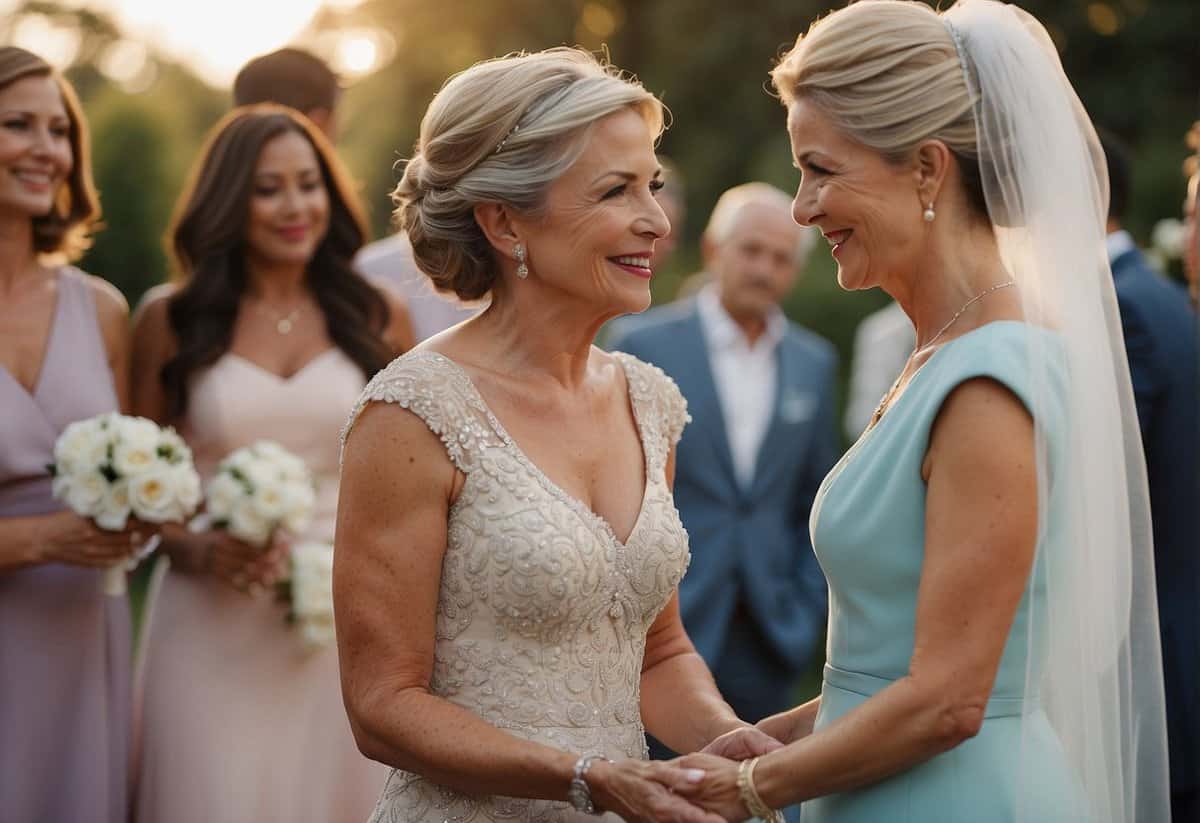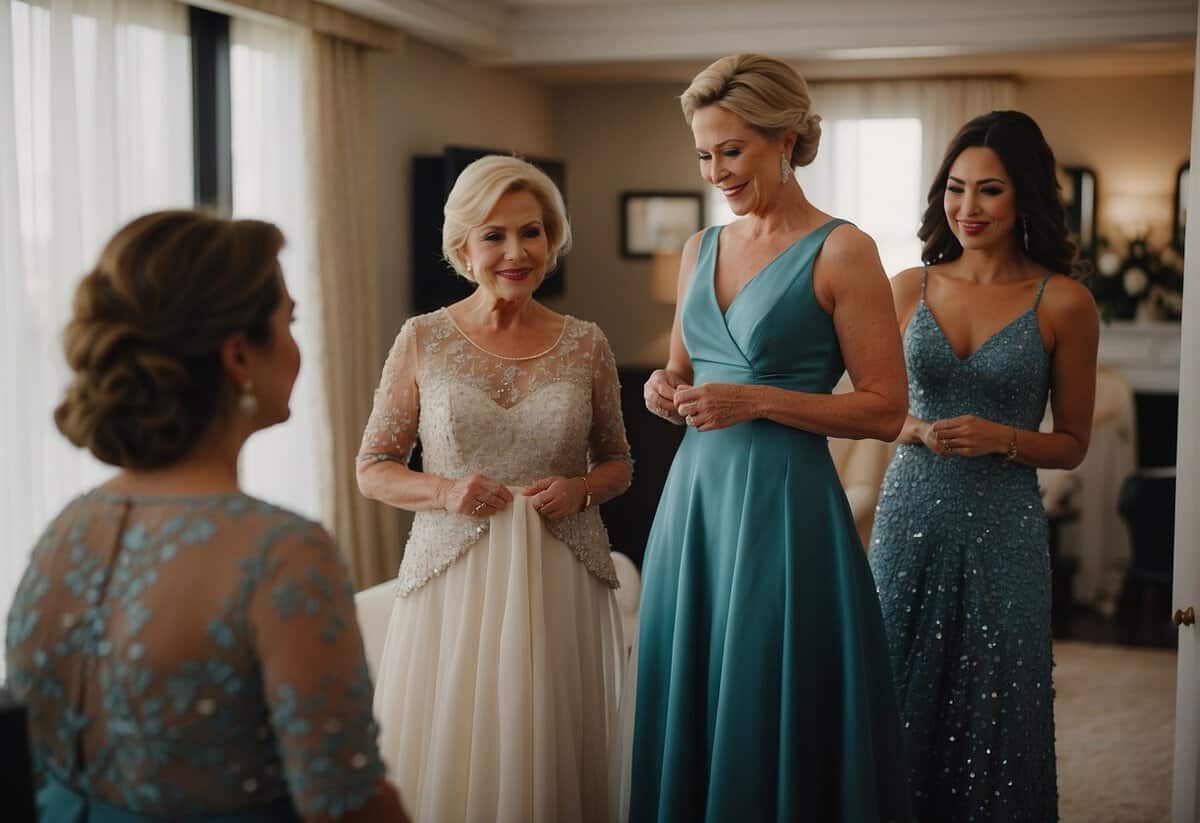Does the Mother of the Bride Pick Her Dress Color First? Etiquette Explained
Traditionally, the mother of the bride plays a significant role in a wedding, and her attire is a subject of particular interest and tradition. It is customary for the mother of the bride to choose her dress color before the mother of the groom selects hers. This practice ensures that their outfits harmonize with the wedding’s color scheme and avoids any potential clashes. It’s important that she communicates her choice to the mother of the groom to coordinate their looks. The mother of the bride may also want to consider the wedding’s theme, season, and time of day when selecting her dress.

When selecting her dress, the mother of the bride should also take cues from the bride’s preferences and the overall style of the wedding. The color and style should complement, not only her personal taste and comfort but also the attire of the bridal party. Consulting with the bride can provide valuable insights into which hues will work best for the wedding palette. The goal is to look cohesive with the wedding’s aesthetics while allowing the mother of the bride to feel confident and elegant on this special day.
Key Takeaways
- The mother of the bride typically selects her dress color first.
- Communication with the mother of the groom is essential to coordinate attire.
- The dress should align with the wedding’s theme and the bride’s preferences.
Dress Selection Protocol for the Mother of the Bride

When you, as the mother of the bride, begin your dress selection, consider it an important role that contributes to the harmony of the wedding aesthetic. Your dress color and style choices, while unique, should elegantly blend with the wedding’s overall theme.
The Importance of Color and Style Choices
Your dress color is more than just a personal preference; it’s a statement of elegance and respect for the day’s importance. It’s customary for you to choose a color that complements but doesn’t match the bridal party. You might opt for a deeper shade or a subtle contrast to the bridesmaids’ dresses rather than an exact match, ensuring both distinction and cohesion within the wedding palette.
Synchronizing with the Wedding Theme and Color Palette
Aligning your dress with the wedding’s theme and color scheme is pivotal. Whether the color palette is soft pastels or vibrant hues, your dress should reflect the chosen motif. For a seamless look, consider discussing options with the bride to ensure synchrony, especially if the wedding has a specific motif like a beach theme or a garden setting.
Understanding the Wedding Dress Code
The wedding dress code dictates not just the formality but also the appropriateness of attire. For formal evening events, a sophisticated gown might be in order, whereas a semi-formal daytime wedding might call for a lighter, more fluid dress. If it’s a black-tie affair, it’s increasingly acceptable for you to wear black, provided it aligns with the time of the event and the formal nature. Above all, make sure to communicate with the bride, as you will often select your attire after the bride has chosen her gown but before the rest of the mother of the bride dress choices are finalized.
Coordinating with Other Key Members

When preparing for a wedding, a key task for you as the mother of the bride is to harmonize your dress with other pivotal members of the ceremony. This coordination respects the visual cohesion of the wedding party and honors the couple’s chosen theme.
Aligning with the Mother of the Groom’s Attire
It is traditional for you to select your dress first, and then communicate with the mother of the groom to guide her choice. Consider informing her of your dress color and style. Aim for attire that neither matches exactly nor clashes—complementary shades are your safest bet. Sharing swatches or shopping together could be a delightful way to ensure cohesiveness.
Complementing the Bridesmaids and Wedding Party
Your dress should harmoniously complement the bridesmaids’ attire, without mirroring it. If they are wearing pastel tones, for instance, you might select a deeper hue within the same color palette. Remember, your role is distinctive from that of the bridesmaids, and your dress should subtly reflect this.
- Avoid matching the bridesmaids’ dresses in color and tone.
- Consider the wedding’s color scheme—neutrals, pastels, or jewel tones—and select a dress that pairs well.
- Keep in mind the formal nature of your attire, which often falls between the formality of the bridesmaids and the bride.
Selecting the Perfect Mother of the Bride Dress

Choosing your mother of the bride dress involves finding a balance between personal style, comfort, and the wedding’s overall theme. Here’s how you can pick a dress that feels right for you and fits the occasion perfectly.
Evaluating Dress Styles and Formality
When starting your search, consider the formality of the wedding. If it’s a formal affair, you’ll want to look for an elegant ballgown or a floor-length dress that aligns with the event’s tone. For less formal weddings, a sophisticated cocktail dress might be more appropriate. Your choice of style should reflect the significance of your role while staying in sync with the wedding party.
Consideration of Comfort and Personal Style
It’s crucial that your dress not only looks good but also feels comfortable. Since you’ll be wearing the dress for several hours, prioritize comfortable fabrics and a style that fits your body shape well. Your dress should also reflect your personal style, making you feel confident and beautiful on this special day.
Seasonal Considerations for Dress Selection
Your dress should also be appropriate for the season of the wedding. Lighter fabrics and shorter sleeves are suitable for summer, while richer textures and layers fit the colder months. If you’re attending a beach wedding, lighter and more breathable materials might be best. Always consider the weather and venue when making your selection.
Final Fittings and Alterations
Once you have chosen your dress, schedule a final fitting close to the wedding date to ensure the perfect fit. It’s not uncommon for your body to change a little in the months leading up to the wedding, so plan for possible alterations. An ideally altered dress will allow you to move with ease and grace throughout the event.
Frequently Asked Questions

In the intricate dance of wedding attire selection, your role is pivotal. Here’s how to navigate the tradition and etiquette surrounding your dress as the mother of the bride.
What is the traditional process for selecting the mother of the bride’s dress color?
Traditionally, you select your dress first, setting the tone for the wedding’s formal attire. After your choice is made, you’ll inform the mother of the groom to ensure harmony in the color scheme.
Is there a particular etiquette the mother of the bride should follow when choosing her dress?
Yes, etiquette suggests consulting with the bride on color preferences and considering the wedding’s venue, vibe, and season to ensure your attire is appropriate and respectful of the couple’s vision.
How should the mother of the bride’s dress color complement the wedding’s color palette?
Your dress should align with the wedding’s color palette without overshadowing the bride. Aim for hues that complement or tastefully contrast with the overall scheme. Avoid matching the bride’s dress or choosing colors too jarring against the chosen palette.
Is it appropriate for the mother of the bride to match the bridesmaid dresses?
It’s best not to match the bridesmaids’ dresses exactly, as you want to stand out as a key figure without appearing as a member of the bridal party. Choose a color that complements the bridesmaids’ attire while remaining distinct.
Can the mother of the bride wear black to the wedding?
Wearing black is acceptable, especially for black-tie weddings, but always check with the bride first. If the wedding features bright colors, the bride may prefer you in a coordinating shade rather than black.
Should the mother of the bride coordinate her outfit with the mother of the groom?
It’s advised that you communicate with the mother of the groom about your attire. While your outfits do not have to match exactly, they should be of a similar style and formality to present a unified look.

